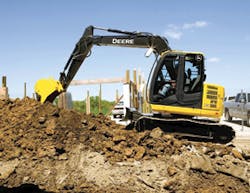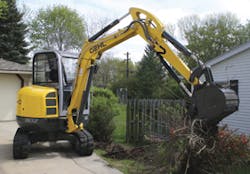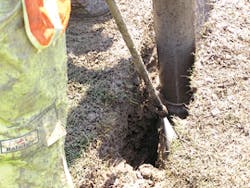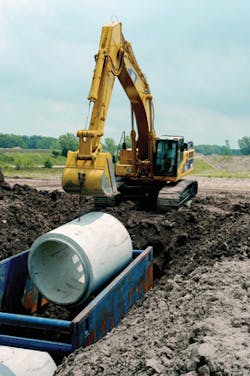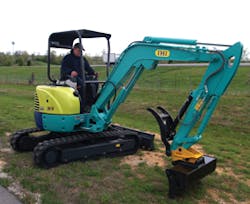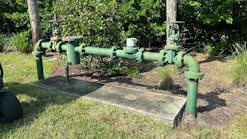Everybody recognizes an excavator. When I was much younger, all my friends called them diggers, because that is what they did. Some people called them shovels, too. That’s what they were and are: mechanical shovels that complete the job more quickly and less laboriously than manual shoveling. They used to dig (excavated, if you want to talk technical) usually in enormous quantities, and they sometimes loaded dump trucks with so much earth that the trucks shuddered at the impact. Who would have believed that some of today’s excavators can drive through garden gates or work right next to the house walls? Some of them have hardly any tail swing. The history of the excavator is testament to the engineering and imagination of the manufacturers who have produced them. Today, you can get an excavator of almost any size, and, whichever brand you favor, you can be confident it is a well-made machine, built to work for several years. The enormous amount of earthmoving that has helped the US grow in the last 60 years has most frequently been achieved with excavators. This would be a good place to recognize and praise the work of companies like Caterpillar, Komatsu, Volvo, John Deere, Kubota, Hyundai, Doosan, Link Belt, Case, Kobelco, Gradall, JCB, Liebherr, Hitachi, Yanmar, New Holland, Takeuchi, and IHI. In the next few years, there will be more names that become recognized as leaders, and this competition between manufacturers will benefit every customer.
The image of the excavator as that huge machine on the job site has faded, because there are excavators today that look almost like toys. They still do a great job of excavating, making narrow trenches and small pits so essential to many projects. They can work close to buildings, right next to the house or school; they can get almost anywhere. They can maneuver and swing with no interference to nearby properties. There are still big excavators, whose buckets seem about the same size as a dump truck, whose excavation makes short work of space for foundations and whole developments. There are many, many sizes of excavators (plus buckets and attachments to work with them). They are made by the famous manufacturers mentioned above, and by excellent companies that you didn’t think would make excavators, like Ditch Witch, Vermeer, Bobcat (part of Doosan), Mustang, and Gehl, companies with great reputations already in other sectors of construction.
In Caterpillar’s comprehensive range of hydraulic excavators, you can find: Mini-with net power from 13 horsepower to 55.6 horsepower, and
Smaller excavators have shown their usefulness at everyday job sites.
operating weights from 2,060 pounds to 18,519 pounds; Small-with flywheel power from 80 horsepower to 125 horsepower, and operating weights from 27,514 pounds to 43,872 pounds; Medium-with net flywheel power from 148 horsepower to 268 horsepower, operating weights from 44,820 pounds to 78,634 pounds; Large-with net flywheel power from 291 horsepower to 523 horsepower, operating weights from 100,040 pounds to 187,360 pounds; and Ultra High Demolition-with net power from 270 horsepower to 530 horsepower, and operating weights from 105,601 pounds to 217,596 pounds. So we can’t ever say that there’s just not the right size excavator for our jobs!
They don’t just dig, do they? They don’t use only one kind of bucket. Excavators have powerful lifting power for moving pipe, materials, and equipment. They can have extra-long reach for specific applications in town and down by the river. They can reach way up in the air to demolish tall buildings, reach down to make the holes that will become parking garages and supports for skyscrapers. If we list all the applications where an excavator would be our best machine, we’ll discover that excavators are all powerful, yes, but they are as versatile as the attachments they use, including buckets. Excavators (like loaders) can be perceived as tool carriers as well as diggers, because an excavator with an array of attachments can do so many jobs at the site that used to require more than one machine and more than one employee. Excavators make the point that, however expensive they seem to be, good machines usually end up over the years as less costly and more reliable than many workers.
Improvements Keep Coming
You might think that, in tough construction times like these, the manufacturers of excavators would sit on their laurels and wait before adding design and function improvements to their machines. The evidence of the last two years contradicts this. Most of the major manufacturers have introduced new, helpful features to their equipment. It’s as if they all believe that being the best is the only way to compete-and what is wrong with that?
Some improvements are mandatory, like compliance with the EPA Tier 4 (EU Stage III-B) emissions. Case, Deere and LBX have been front runners in compliance. Case uses CEGR (cooled exhaust gas recirculation) for its C-Series. Contractors were worried that the new emissions rules would affect fuel consumption as well as prices, but Case reveals that, while a typical CEGR system may cause a loss of fuel efficiency, their C-Series excavators have fuel efficiency increased by as much as 10% over the popular B-Series excavators. Deere asserts that its new models in the mid-range arena (weights from 40,000 to 60,000 pounds, among the most popular sizes in North America) will, despite Tier-4 compliance, offer better productivity and lower operating costs. One way that Komatsu is helping to lower operating costs is by matching the engine speed to pump delivery.
On the Hyundai 9-Series excavators, you will find the engine and hydraulic technologies improved, and they have the CAPO computer-aided system of power optimization. To access important machine information there is the HI-mate remote management system, which uses GPS and an Internet-based interface. You can access that information from anywhere in the world. As to operator comfort, the Hyundai 9-Series excavators offer bigger, reinforced cabs. Komatsu’s hybrid excavator (the PC290LC-10) offers performance almost identical to its non-hybrid relation but it has a system where it generates electricity every time the operator brings the upper structure to a halt. The AC energy developed by the stopping of the swing motor goes via an inverter to convert it to DC energy, and it is stored in a capacitor. This excavator also has the latest Komtrax technology, which sends machine operating information to a secure website using wireless technology. Data such as operating hours, location, cautions and maintenance alerts are sent to the web application for analysis.
There’s nothing weaker or inferior about the Cat 336E excavator, one of the first from that manufacturer to comply with the EPA Tier-4-Interim emissions requirements. With a Cat C9 engine for power, this excavator gives more power (18%), accurate fuel delivery (a feature that is surely becoming more and more important), superior electronic control, and improved air management. The 336E has more lifting capacity, thanks to its stronger boom, arm, and swing frame. There are practical improvements in the cab, too. Meanwhile, Volvo moves forward with its broad range of equipment and one that caught my imagination is the EC460CHR, a high-reach excavator that has impressive demolition credentials. High reach? The boom and arm on this Volvo excavator is 89 feet, 7 inches. It takes only 30 minutes to change this model from standard to high reach. Power comes from a 329-horsepower engine. One of the benefits that has always appealed to me about Doosan equipment is the manufacturer’s 48-hour parts guarantee; it could be a most serious consideration in these days of tight bidding when all downtime is terrible. The company reminds us that the powerful DX300LC crawler excavator offers this feature, too. If a machine requires a “machine-debilitating” part, Doosan will deliver that part to the end user within two business days or Doosan will pay for a replacement machine rental.
Buckets and Other Things up Front
There are 16 different types of buckets listed on Caterpillar’s website, and most of those types come in multiple sizes. As the sizes of excavators have evolved, so have the buckets that serve them best. Feedback from users has shown manufacturers what is needed in a productive bucket for this or that situation. Manufacturers who offer buckets for their excavators will tell you that their buckets have been designed and made to fit exactly the machines offered, and that makes sense. But don’t, please, assume that the products of independent manufacturers, whose only products are attachments like buckets, breakers, and quick couplers, are any less well made or designed. There have always been (and probably always will be) alternative parts and replacement parts that are not quite of the same quality as your original equipment, but that’s part of your responsibility as an owner and purchaser, to base decisions on the quality of the product rather than on its price. Your dealer should be able to advise honestly on this subject. With excavators more than any other construction equipment, you have to do some research or homework. It will take time. There are many options available, but the best option for you is probably available; you must hunt for it, tell dealers and manufacturers what you need.
Some of yesterday’s best known independent brands of attachments have been bought by leading machine manufacturers like Komatsu and
Wherever the job site, today’s excavators can work accurately and quickly.
Caterpillar, surely proof of the merit of those independent companies. Today, the Paladin Construction Group includes JRB, CP, and CustomWorks, and those include well-proven and respected names like Bradco, Sweepster, FFC, Harley, and McMillen. The JRB PowerLatch (designed by Miller of global renown) must be one of the safest, most advanced quick couplers for excavators (and loader backhoes). It has the patented Automatic Blocking System (ABS) and mechanical locks on both front and rear attachment pins independent of the machine’s hydraulic locking and operating system. The ABS mechanical backup safety system automatically locks both pins so that the coupler engagement is maintained even if a hydraulic failure occurs. Among Paladin’s other products is the CP Scoop Bucket which lets the excavator operator cut through the ground more efficiently to hold more material and a higher payload. It’s just a bucket! … but designed for better-than-average results.
Another independent company with loyal customers for many years is the Helac Corp. It’s most famous for its products’ tilting capabilities. The Helac Power Tilt will tilt any bucket or attachment up to 180 degrees. Ditches, slopes…the number of jobs where a bucket that tilts from the excavator boom is soon recognized. It’s one of those inventions that makes you wonder why nobody else thought of it long ago. The most obvious savings come from not having to reposition the excavator as often, and increases in productivity up to 70% have been reported. Thomas Construction Co., a client for about 10 years, using the PowerTilt on a Cat 330CL excavator, says it doubled productivity thanks to the efficiencies offered by the tilt’s operational technology. Contractors say that the Helac Power Tilt not only improves the excavator’s versatility but also saves having to bring extra equipment to sites that aren’t perfectly level. The cuts, too, tend to be more precise. At Wisconsin’s DNR, they say that Helac’s PowerGrip (a multipurpose jaw bucket with enclosed rotary actuator hinge technology) eliminated some of the problems they had experienced previously in maintenance and service.
Hydroexcavation gains popularity for work around buried utilities.
Let’s mention one more independent manufacturer: Rockland Manufacturing Co. The company’s Krypto Klaw can scoop up small debris for land clearance and demolition jobs much better than a “standard” bucket. The wide, heavy-duty Krypto Klaw pleases operators because, once the load is clamped with the dual-cylinder clamping force, they simply curl the bucket to position the load, and they get 100% of the excavator’s reach. This excavator attachment will grip, pull, sift, stack, carry, and load all with one “bucket.” Installation is easy because no welding is necessary. It can be used with pin grabber couplers whenever it’s needed. This ease of installation has made it popular with those who have several machines, and for rental yards. Rockland also offers a concrete crusher, excavator rake, ripper, stump splitter, slope packer, compaction wheel, backfill blade, excavator dozer blade, and clearing splitter. When you consider your next excavator, think beyond the bucket! The power you’re buying can do hundreds of different tasks at the job site, with one machine and one operator.
Safety in Excavation
This should be unnecessary. You’d think that, by the end of 2011, everybody who had to dig down a few feet with a sharp, heavy edge would have found out what is underground already. Not long ago, a careless boss (almost in my neighborhood, so I won’t mention names) told his employee. “Start the excavation there.” The operator positioned his excavator and began digging, for just a second or two. Swing. Slice. Oops. Luckily it wasn’t a gas or electric line. There was no explosion, but the cost was probably as much as the profit from the whole job. How could the boss, who has lived here all his life, not know what was laid below ground by the hospital? His crews had never dug there before, but his crews did not win the last contract, a year ago, when the cables were laid. Call before you dig. How often must it be said?
Safety at any excavation site is the first consideration. With so much equipment buried (deliberately) underground in recent years, it is even more
The lifting power of excavators makes them multipurpose machines.
important now. There is an area of excavation that has been developed to promote safety, especially where the underground utilities are gas, electric, water, telecommunications, and sewer. Damage to any of those can cause widespread problems in a community. When you know you will be digging near buried cables, wire and pipe, you could consider vacuum or hydro excavation for that part of the project.
Hydroexcavation is a technology gaining wider acceptance. Basically, it’s digging with pressurized water and a simultaneous vacuum. “In Canada,” explains Mike Clark, CEO of H2X, “no excavation company is allowed to work on underground utilities until they have exposed those utilities through vacuum excavation. While the US “hydrovac” industry still lags behind its Canadian counterpart, more infrastructure owners (municipalities, oil-and-gas companies, utilities) and excavators are no longer willing to shoulder the liability of damaging underground infrastructure. That means fiber optic or natural gas pipelines or other utilities that may be expensive, delicate, or dangerous are now increasingly off limits until they have been exposed by nondestructive hydro excavation.” Clark estimates that hydro excavation in the US is “maybe 5%” into its growth curve. If the Canadian saturation of hydro excavation trucks were to be transferred to the US, we would have more than 10,000 hydrovac trucks in this country. “I don’t think there are more than three or four hundred,” says Clark. That could be changing.
“We have been doing lots of missionary work talking about hydroexcavation for the eleven years we’ve been in business,” adds Clark. H2X has 25 hydroexcavation trucks. “Just in the last 18 months or so we’ve seen a new acceptance of the technology and a willingness to make the commitment to a nondestructive way of working on underground utilities. We are all going to be safer, as a result.” Clark singled out companies like Occidental Petroleum and Kinder Morgan as examples of large infrastructure owners making a corporate commitment to safe excavation. “Hydro excavation will never compete costwise with a backhoe or excavator in open ground over a long distance,” concludes Clark. “But if you aren’t certain where those underground utilities are, avoiding one line strike pays for our services many times over.”
This excavator’s bucket has a thumb for good retention.
To achieve similar safe results when there are buried utilities, there is also vacuum excavation. Air-Vacuum excavation systems (such as those from Vacmasters, a division of Barone Inc.) use high-pressure air in combination with a powerful vacuum to first break up the soil and then remove it. This process lets you dig a trench or pothole quickly, easily, and safely. When the underground obstacles have been exposed, the exact location is marked and the removed spoils are put back in the hole as backfill. Air-vacuum excavation systems avoid the labor of manual digging (itself not so safe for sensitive cable!) and, because the spoils stay dry, provide backfill immediately. Also, there are no spoils disposal costs. Vacmasters offers several sizes of systems, from trailer-mounted to powerful truck-mounted versions.
Making the Excavator More Valuable
The quality of excavators is better than ever. How can we improve on that? Our first goal could be to ensure that the operator knows how to take advantage of everything that is now offered on “standard” machines. Find out what is included in the excavator you fancy. More manufacturers seem to be offering onboard systems that can help you locate every machine (wherever it is, wherever you are) and accuracy in grade control, thanks to GPS, is almost standard. Find out what you can get as part of your excavator package and then make sure your operators know how to use the features to reap the benefits. That could involve training on specific aspects of operation and you hate to spend more money when you have just spent a small fortune on the machine itself. Ask successful contractors and they’ll tell you that their projects run best when all the crews and operators know what they are supposed to be doing and how to do it correctly. There’s little point having a costly machine if you only use half its capabilities. So let’s look at training again. It’s not a waste of time and it could make thousands of dollars with the time it saves by doing the job right the first time.
Along with the improvements in the basic excavator, there are products available that can increase its performance at relatively little extra cost. In several issues of Grading & Excavation Contractor this year there have been practical articles about what is available for, say, machine guidance and control, successful products from companies like Leica, Topcon, and Trimble. How much does an excavator make when it is operating? What if it could make the same amount in two-thirds of the time used until now? The worst enemy of productive earthmoving must be rework; many of the programs available will help you avoid that horror.
You’ll hear GPS mentioned frequently when you listen to talk about technological aids for better excavation. GPS has been around for a long time now, almost 40 years, but it is not just a gimmick that can find the nearest pizza place. GPS stands for Global Positioning System and its basic task is to pinpoint the location of anything. It could be your car in relation to the pizza place, but it could be your excavator (or any other equipment). Grading is more accurate, and you won’t need four or five passes to get it right, even if the operator of the machine is not especially expert. Systems with GPS in them help your workers do a better job and they help you know how everything is going, where every machine is, and how to do that without extra employees to check everything as in the “old days.” GPS will also help you get accurate information from the job site to show what has been achieved by your crews, or not achieved. You can get reports to be read by those who need them. It can make billing faster and more accurate. GPS, then, is not just another set of gimmicky initials. Ask your manufacturer or dealer what GPS programs could enhance your excavator’s performance, and your bottom line.
They are still the kings of the job site (presidents or prime ministers if you prefer) but they are so much more than a generation ago. It may be time for us to stop thinking of excavators as simply the deep diggers and to see them as some of the most powerful and versatile tool carriers to have available at every job site.
